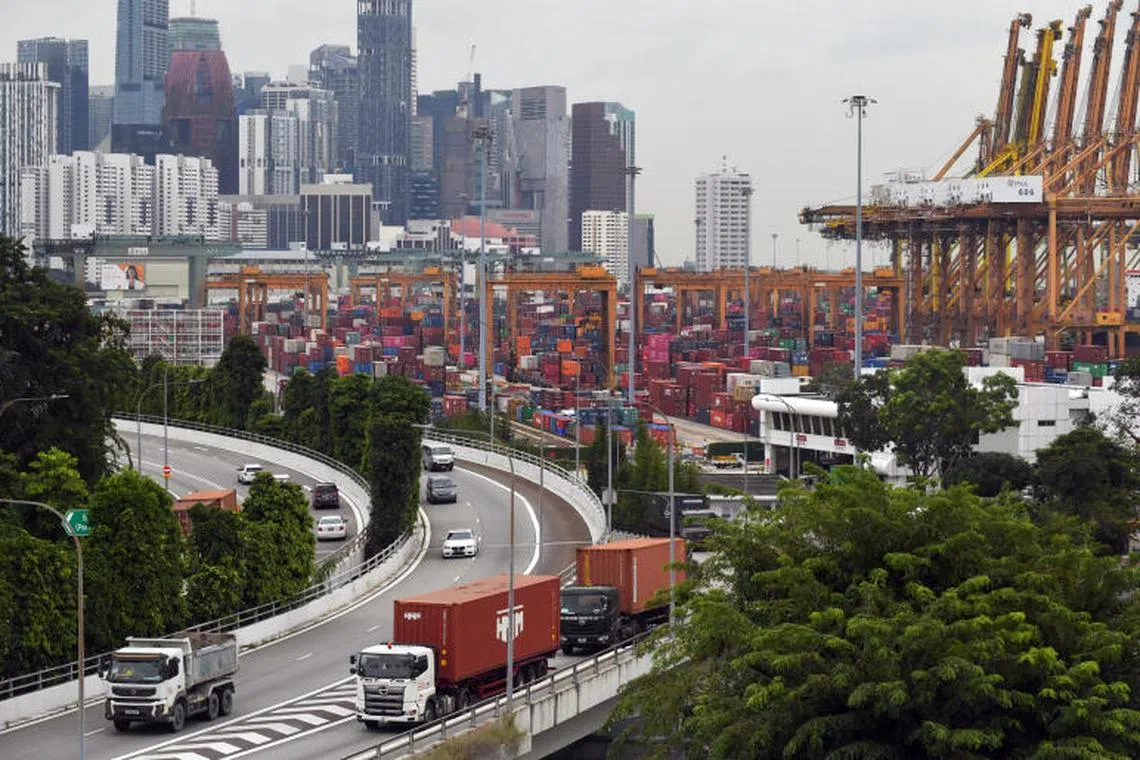Singapore key exports fall 15.6% in February in 5th straight month of contraction
Sign up now: Get ST's newsletters delivered to your inbox

Non-oil domestic exports in February dropped 15.6 per cent, after falling by 25 per cent in January.
PHOTO: ST FILE
Follow topic:
SINGAPORE – Singapore’s key exports declined less sharply in February on a yearly basis, but economists said there was little reason to cheer.
External demand is unlikely to pick up any time soon as bank turmoil in the United States and Europe could lead to a more cautious approach to lending. Tightening financial conditions will also weigh further on the global economy, which is already facing the spectre of recession.
Non-oil domestic exports (Nodx) in February shrank 15.6 per cent from a year ago, after falling 25 per cent in January and 20.6 per cent in December, data from Enterprise Singapore (EnterpriseSG) on Friday showed.
It marks the fifth straight month of year-on-year decline of Singapore’s key exports as both electronic and non-electronic shipments fell.
ANZ head of Asia research Khoon Goh noted that the timing of Chinese New Year had exaggerated the January weakness. He said goods exports remained very weak, with “Nodx now at its lowest levels since June 2019”.
On a month-on-month, seasonally adjusted basis, Nodx fell by a hefty 8 per cent to $13.3 billion, after the previous month’s 0.9 per cent growth. The drop was worse than the 0.5 per cent forecast in Bloomberg’s poll of analysts.
In real terms – after adjusting for the effect of price changes – Nodx fell by 12.2 per cent in February, better than the corresponding 20.7 per cent fall in January.
Electronic products, which account for around a quarter of domestic exports, contracted another 26.5 per cent in February, a slight improvement from the 26.8 per cent slump in January. Integrated circuits, disk media products and capacitors contributed the most to the fall in electronic shipments.
Maybank Securities economists Chua Hak Bin and Lee Ju Ye said in a report that electronic shipments will likely remain weak as the global growth downturn continues to weigh on demand. As an indication of the broad weakness in electronics, exports of chip powerhouses such as South Korea and Taiwan also underperformed in the first two months of the year, they added.
Non-electronic products shrank less sharply in February, slipping 12.1 per cent after contracting 24.5 per cent in January. Structures of ships and boats, petrochemicals and pharmaceuticals contributed the most to the decline.
Breaking down by export markets, shipments to Singapore’s top 10 markets declined as a whole in February. The falls were led by double-digit drops in exports to the European Union, Hong Kong and Taiwan.
In particular, shipments to the EU reversed the previous month’s gains to fall 34.2 per cent year on year, due mainly to falls in exports of pharmaceuticals, petrochemicals and disk media products.
Intra-regional trade improved slightly as shipments to Thailand rebounded, and shipments to Indonesia and Malaysia did not contract as badly as in January.
Exports to China remained in the red, but the decline narrowed in February, down 11.3 per cent compared with the previous month’s 41.1 per cent fall.
Barclays senior regional economist Brian Tan said the smaller decline in exports to China was mainly due to an increase in shipments of non-monetary gold. He added that the data has yet to show a significant lift from the economic reopening in China.
The US was a bright spot for Singapore’s exports as shipments rebounded 8.7 per cent after falling in January and December.
Maybank Securities expects exports to shrink in the first half of the year. The brokerage is downgrading its 2023 Nodx forecast to a range of between minus 7 per cent and minus 4 per cent.
“This will be the worst export performance since the 2019 chip downturn, when Nodx plunged by minus 9.2 per cent,” the brokerage said.
UOB is keeping to its forecast for Nodx to contract by 5.5 per cent this year. The bank’s senior economist, Mr Alvin Liew, said there are likely to be “a few more months of year-on-year declines in Nodx in the first half of the year” before exports start to improve in the second half.
He said “further monetary policy tightening and worries about the economic slowdown in the developed markets” are expected to weigh on global demand for Singapore’s exports.
Singapore is one of the most export-driven economies in the world, with an exports-to-gross domestic product ratio of about 180 per cent.
The Government’s Nodx forecast for 2023 is for minus 2 per cent to 0 per cent growth, and Maybank Securities expects EnterpriseSG to cut its forecast in the next review in May.
ANZ’s Mr Goh said that while goods exports will be a big drag on economic growth, services exports (due to tourism) will help to make up for some of the shortfall.
He added that the poor export outlook is not a major consideration for the Monetary Authority of Singapore (MAS) when it meets in April.
“Next week’s consumer price index data will be important as inflation remains the dominant concern at this point. We still expect the MAS to tighten policy at its April review,” said Mr Goh.



